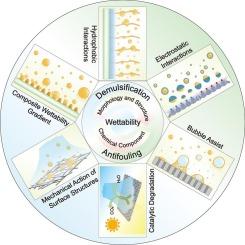Demulsification and antifouling strategies for superhydrophilic oil-water emulsion separation materials: A review
IF 7.3
2区 材料科学
Q1 CHEMISTRY, APPLIED
引用次数: 0
Abstract
Efficient separation of oil-water emulsions remains a critical challenge in industrial wastewater treatment, oily water purification, and marine oil spill recovery. Superhydrophilic separation materials, with their high separation efficiency, low energy consumption, and absence of secondary pollution, have emerged as an ideal solution. Within these materials, demulsification and anti-fouling strategies are central to achieving efficient emulsion separation. However, solely enhancing demulsification capability enables high-efficiency separation in the short term, yet insufficient anti-fouling capacity leads to fouling, causing sudden flux decline. Conversely, merely improving anti-fouling ability can maintain stable flux, but inadequate demulsification results in low separation efficiency. Therefore, synergistically enhancing both demulsification and anti-fouling is crucial to achieving stable and long-lasting separation. Despite extensive recent progress, comprehensive reviews integrating demulsification and anti-fouling remains relatively scarce. This review aims to address this urgent need, focusing specifically on membrane-type superhydrophilic materials. It provides an in-depth analysis of the advances in their demulsification and anti-fouling strategies. First, it introduces the fundamental mechanisms governing surface wettability regulation. Subsequently, from a performance perspective, it outlines the key factors and parameters influencing separation effectiveness. Building upon a comprehensive summary of recent strategies for enhancing demulsification and anti-fouling capabilities and their underlying mechanisms, this review objectively analyzes the prevalent challenges and limitations of current approaches. Finally, it provides valuable guidance for the future design and optimization of advanced oil-water separation materials.

超亲水油水乳液分离材料的破乳防污研究进展
油水乳液的高效分离一直是工业废水处理、含油水净化和海洋溢油回收的关键挑战。超亲水分离材料具有分离效率高、能耗低、无二次污染等特点,是一种理想的分离材料。在这些材料中,破乳和防污策略是实现高效乳液分离的核心。然而,单纯增强破乳能力可以在短期内实现高效分离,但抗污能力不足会导致结垢,导致通量突然下降。相反,仅提高抗污能力可以保持稳定的通量,但破乳不足导致分离效率低。因此,协同增强破乳和防污是实现稳定和持久分离的关键。尽管近年来取得了广泛的进展,但整合破乳和防污的综合综述仍然相对较少。这篇综述旨在解决这一迫切需求,特别关注膜型超亲水材料。深入分析了它们的破乳和防污策略的进展。首先,介绍了控制表面润湿性调节的基本机制。随后,从绩效的角度概述了影响分离效果的关键因素和参数。在全面总结了近年来提高破乳和抗污染能力的策略及其潜在机制的基础上,本综述客观地分析了当前方法的普遍挑战和局限性。最后,为未来先进油水分离材料的设计与优化提供了有价值的指导。
本文章由计算机程序翻译,如有差异,请以英文原文为准。
求助全文
约1分钟内获得全文
求助全文
来源期刊

Progress in Organic Coatings
工程技术-材料科学:膜
CiteScore
11.40
自引率
15.20%
发文量
577
审稿时长
48 days
期刊介绍:
The aim of this international journal is to analyse and publicise the progress and current state of knowledge in the field of organic coatings and related materials. The Editors and the Editorial Board members will solicit both review and research papers from academic and industrial scientists who are actively engaged in research and development or, in the case of review papers, have extensive experience in the subject to be reviewed. Unsolicited manuscripts will be accepted if they meet the journal''s requirements. The journal publishes papers dealing with such subjects as:
• Chemical, physical and technological properties of organic coatings and related materials
• Problems and methods of preparation, manufacture and application of these materials
• Performance, testing and analysis.
 求助内容:
求助内容: 应助结果提醒方式:
应助结果提醒方式:


